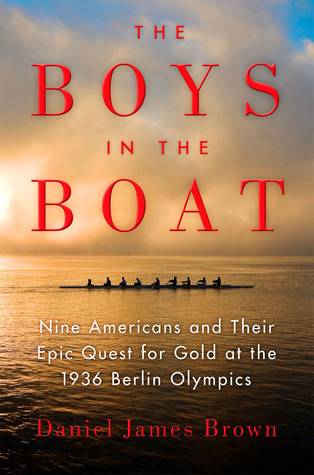 The Boys in the Boat: Nine Americans and Their Epic Quest for Gold at the 1936 Berlin Olympics, by Daniel James Brown
The Boys in the Boat: Nine Americans and Their Epic Quest for Gold at the 1936 Berlin Olympics, by Daniel James BrownIf you'd told me I'd finish this book with tears in my eyes, I never would have believed you. I am not an athlete and I know little about rowing crew...my only brush with rowing was when I was a freshman at Pacific Lutheran University, and a member of the crew team approached me in the cafeteria and asked if I'd be interested in becoming a coxswain. (I am only 5' tall.) I wonder how my life would have been different now if I'd said yes. But I am no athlete, and I doubt I could've stuck it out, after reading about the hard training these rowers have to endure.
Daniel James Brown spins a great tale, starting with the heartbreaking childhood of Joe Rantz, the primary protagonist of this book. He delves into the interesting lives of most of the crew team, as well as head coach Al Ulbrickson and shell (boat) builder, George Pocock. The 1936 University of Washington team mostly came from blue collar workers, in contrast to the more educated teams from the East Coast and California.
 The Boys in the Boat takes us from the Dust Bowl to the building of the Hoover Dam, from Eton College in England to eastern Washington, from Seattle and Poughkeepsie to Berlin...to the way Hitler pulled the wool over so many people's eyes, including Avery Brundage. president of the IOC, who refused to believe mounting evidence about the Nazi campaign against the Jews.
The Boys in the Boat takes us from the Dust Bowl to the building of the Hoover Dam, from Eton College in England to eastern Washington, from Seattle and Poughkeepsie to Berlin...to the way Hitler pulled the wool over so many people's eyes, including Avery Brundage. president of the IOC, who refused to believe mounting evidence about the Nazi campaign against the Jews.It's an inspiring story of a small group of nine men, trained by highly driven and skilled coaches, who beat all the odds and build a perfect team together. Like a skilled novelist, Brown uses the technique of building a perfect boat out of Northwest cedar as an analogy for building a finely tuned crew team out of young men like Joe Rantz, who was a man of true resiliency against the odds:
"The result was that the boat as a whole was under subtle but continual tension caused by the unreleased compression in the skin, something like a drawn bow waiting to be released. This gave it a kind of liveliness, a tendency to spring forward on the catch of the oars in a way that no other design or material could duplicate.
To Pocock, this unflagging resilience--this readiness to bounce back, to keep coming, to persist in the face of resistance--was the magic in cedar, the unseen force that imparted life to the shell. And as far as he was concerned, a shell that did not have life in it was a shell that was unworthy of the young men who gave their hearts to the effort of moving it through the water."I found this book to be moving and fascinating. The Gold Medal-winning Husky Clipper still survives--in fact, my alma mater appears in the book as it was lent to PLU in Tacoma in the 1960s. Now it's in Washington's Conibear Shellhouse.
A few weeks ago when we attended a Seattle Mariners' game, I saw a street named after Royal Brougham, the legendary columnist in the Seattle Post Intelligencer who chronicled the rise of this team. What an exciting story this was!
No comments:
Post a Comment